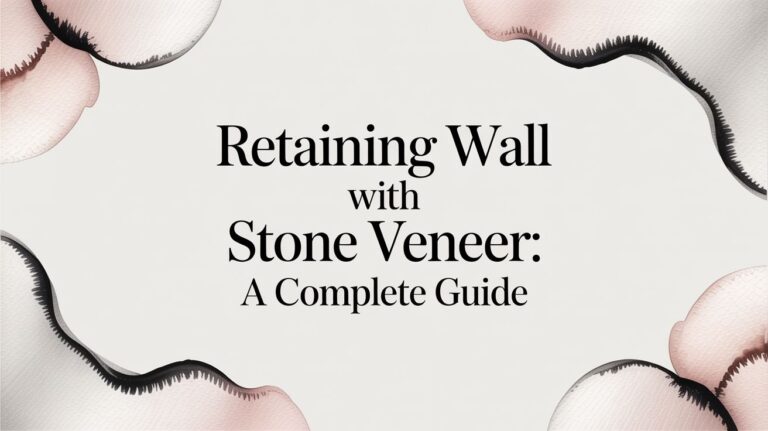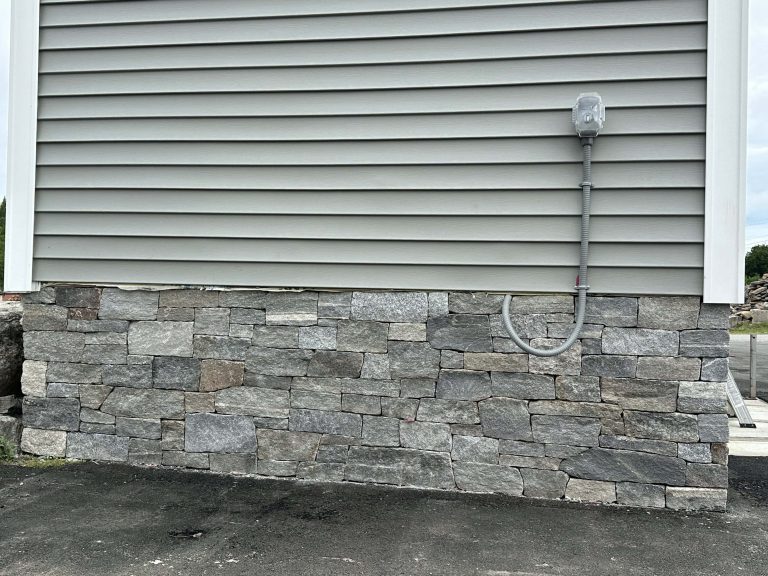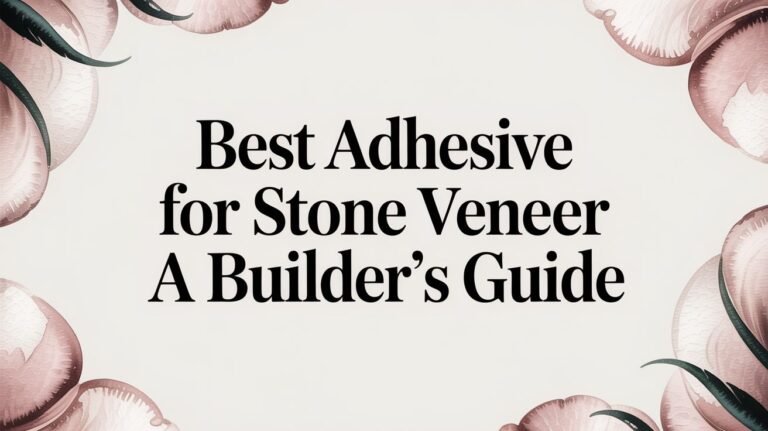A Builder’s Guide to Stone Mailbox Posts
When you build a stone mailbox post with real New England thin stone veneer, you’re creating a statement piece that delivers unmatched durability and curb appeal. We specifically use Harsh Climate Approved fieldstone and quarried veneer, crafted at our Littleton, Massachusetts facility. These posts are built to withstand New England’s freeze-thaw cycles and require minimal maintenance.
Why Authentic Stone Outperforms Other Materials
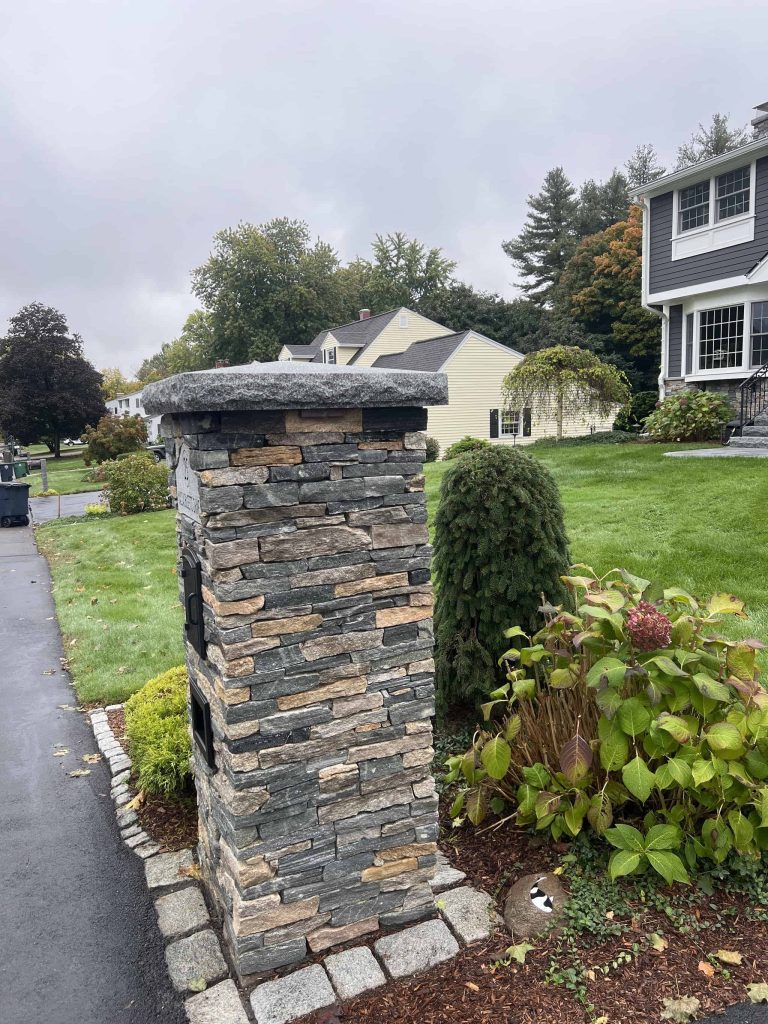
Standard wood or cast concrete posts degrade over time from rot, cracking, and moisture damage. Stoneyard’s 100% natural thin stone veneer provides a classic, full-depth masonry appearance at approximately one-third the weight of full-bed stone. With matching corner pieces available for every blend, a continuous, solid look is easily achieved.
The real-world benefits for builders and property owners are clear:
- Low Maintenance: Real natural stone requires no painting or sealing and resists moisture intrusion.
- Freeze–Thaw Durability: All Stoneyard products are Harsh Climate Approved (HCA) and proven to perform in demanding New England winters.
- Enhanced Value: Authentic stone adds significant resale value and a level of craftsmanship that manufactured materials cannot replicate.
The demand for high-performance materials is growing. The global natural stone market was valued at USD 10.17 billion in 2024 and is projected to hit USD 14.11 billion by 2030, growing at a 5.8% CAGR, according to market analysis from Grand View Research.
Stoneyard’s real stone veneer is hand-sorted and sawn to a consistent thickness of approximately one inch (¾–1¼ inch range) at our Littleton, MA facility. This precision simplifies installation over masonry, concrete, or framed walls prepared with lath and a scratch coat.
Each piece reflects the authentic geology of New England. The color and texture are integral to the stone, running through its entire body. This ensures no fading or surface delamination, a common failure point in pigmented concrete products like those from Eldorado Stone or Cultured Stone.
Natural New England stone veneer delivers multi-decade performance with minimal maintenance and no color fading. Its density provides superior resistance to physical impact compared to cast concrete alternatives.
Installation Benefits and Best Practices
The reduced weight of thin veneer simplifies handling, which can accelerate installation schedules and reduce labor requirements.
- Efficient Handling: Lighter weight makes the material easier for masons to manage on-site.
- Harsh Climate Approved: Every product is tested for durability in freeze-thaw conditions.
- Authentic Colors: Choose from distinct New England color blends like Boston Blend® or Colonial Tan to match any residential or commercial design aesthetic.
Our thin veneer installs cleanly over CMU (concrete masonry unit) cores or framed structures. Both flats and matching corner pieces are available to achieve a seamless, full-depth stone appearance.
Authentic New England thin stone veneer offers the permanence and craftsmanship that manufactured products cannot match.
By choosing Stoneyard’s real natural thin stone veneer, you’re not just installing a mailbox post—you’re adding a lasting architectural feature to a property.
Building the Core Structure and Foundation
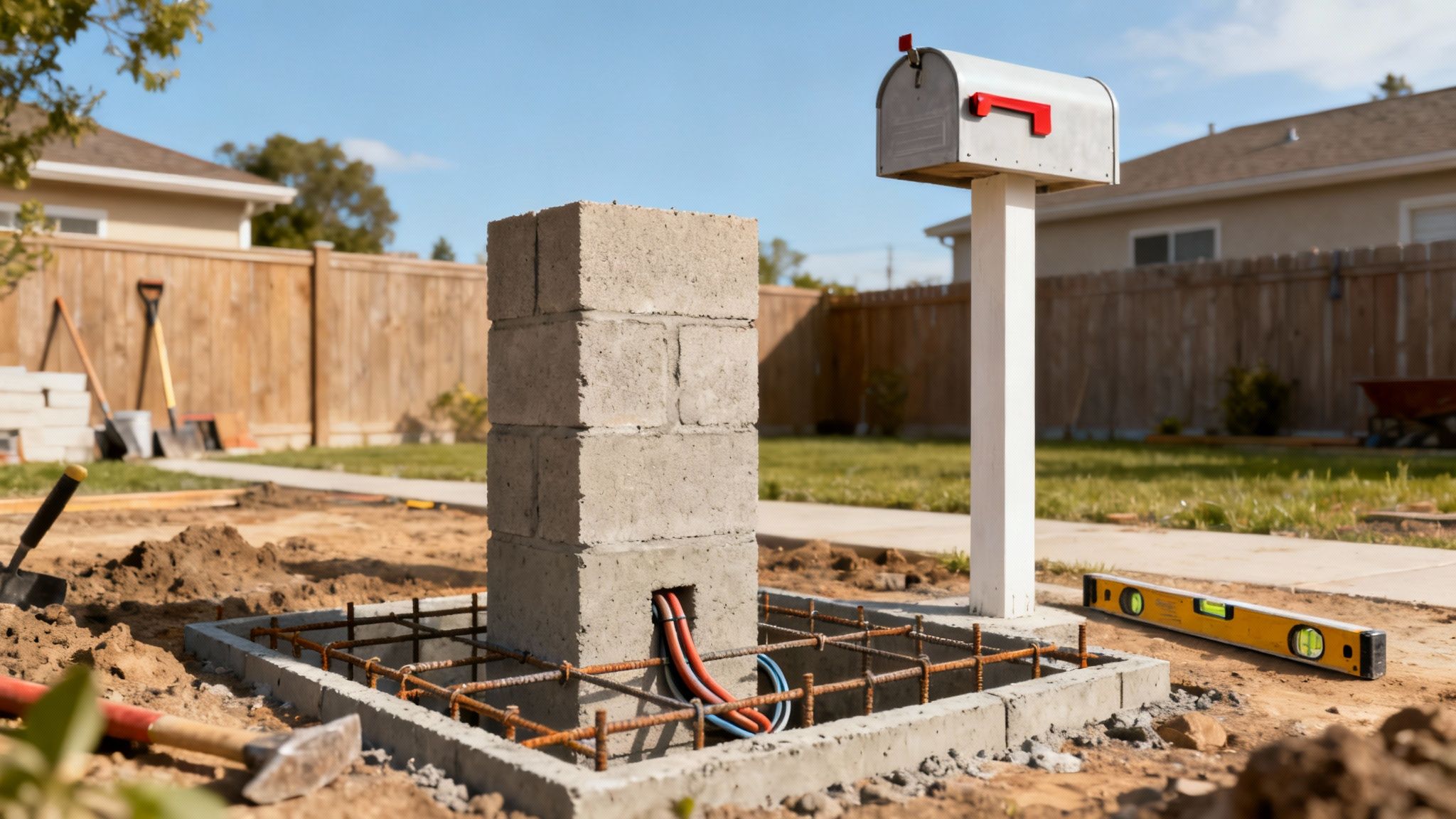
A stone mailbox post clad in authentic New England thin stone veneer is engineered for longevity, but its performance depends on a properly constructed core and foundation. The structural integrity of the project lies in the unseen elements below ground.
Whether the core is built from concrete masonry units (CMUs) or is a poured concrete form, the process begins with a proper footing.
Establishing a Frost-Proof Footing
In New England, the freeze-thaw cycle causes soil to expand and shift in a process known as frost heave. A footing that is too shallow will be lifted by this force, leading to cracked mortar joints and structural failure.
To prevent this, the bottom of the concrete footing must extend below the local frost line. In our region, this is typically between 36 and 48 inches deep. Always confirm the required depth with your local building department.
The footing should also be wider than the post itself to distribute the structural load across stable, undisturbed soil. For more on site preparation, this practical guide to bollard installation offers relevant insights.
Constructing the CMU or Poured Concrete Core
Once the footing has cured, the vertical core can be constructed using one of two methods:
- CMU Construction: Stack concrete blocks with staggered mortar joints for strength. The structure must be kept plumb and level as work progresses. For maximum durability, fill the hollow block cores with concrete and vertical rebar.
- Poured Concrete Form: Build a temporary plywood form to the desired post dimensions, place a cage of steel rebar inside, and fill it with concrete. This creates a solid, monolithic column that provides an ideal substrate for the stone veneer.
An imprecise core will become apparent during stone application and compromise the final appearance.
A professional technique is to run PVC conduit from the base to the top of the core before filling it with concrete. This allows for the future installation of low-voltage landscape lighting without drilling through the finished structure.
Preparing the Substrate for Stone
After the core has fully cured, its surface must be prepared for the thin veneer application. This involves installing a metal lath and a scratch coat.
Securely fasten a galvanized metal lath to all four sides of the post. Apply a layer of mortar—the “scratch coat”—over the lath, ensuring it is pressed firmly through the mesh to create a strong mechanical bond.
While the mortar is still wet, rake horizontal grooves into the surface with a scarifier or notched trowel. This textured surface provides an ideal key for the setting mortar, ensuring a permanent bond for the New England thin stone veneer.
Selecting the Right Stone Shape and Color
A stone mailbox post is the first architectural element visitors encounter. The choice of stone shape and color should align with the property’s design to create a cohesive aesthetic. All Stoneyard thin stone veneer is sourced from New England geology and crafted into five distinct shapes at our Littleton, MA facility.
Finding the Right Shape for Your Home’s Design
Each stone shape provides a different architectural character. Ledgestone, with its thin, linear strips, creates clean, stacked lines ideal for modern or contemporary designs. Ashlar offers a similar rectilinear form but with taller courses for a larger-scale appearance suitable for grander homes or commercial facades.
Conversely, our Mosaic shape consists of irregular, angular pieces that replicate the appearance of classic, hand-laid New England fieldstone walls. It is well-suited for rustic farmhouses, chimneys, and landscape features.
For traditional or colonial architecture, Square & Rectangular stone provides a timeless, orderly pattern. The Round shape, with its weathered, cobblestone appearance, is ideal for projects requiring a historic look, such as farmhouse foundations or coastal restorations.
The objective is to create a seamless visual transition from the curb to the front door. A Greenwich Gray Ledgestone post complements a modern exterior, while a Colonial Tan Round stone post enhances the character of a coastal Cape Cod.
Choosing a Color Palette That Clicks
Color is as critical as shape for achieving a cohesive design. Stoneyard’s five New England color collections are derived from our regional quarries and offer a range of authentic palettes.
- Boston Blend®: Our signature mix of gray, tan, and brown, adaptable to nearly any architectural style.
- Colonial Tan: Warm gold and brown tones well-suited for traditional and coastal designs.
- Greenwich Gray: A neutral gray palette that provides a crisp, modern aesthetic for contemporary homes and commercial projects.
- Newport Mist: Soft grays and whites that create a light, contemporary feel.
- Vineyard Granite: A gray-pink granite with natural mica sparkle for rugged texture and character.
Combining shapes and colors creates numerous design possibilities. A Boston Blend Mosaic post provides rustic charm, while a Newport Mist Ashlar post delivers clean, contemporary lines.
Stone Shape and Color Pairings for Architectural Styles
| Architectural Style | Recommended Stone Shape | Recommended Color Collection | Design Rationale |
|---|---|---|---|
| Modern/Contemporary | Ledgestone or Ashlar | Greenwich Gray or Newport Mist | The clean, linear shapes and neutral gray tones emphasize geometric precision and minimalist aesthetics. |
| Rustic Farmhouse | Mosaic or Round | Boston Blend® or Vineyard Granite | Irregular shapes and earthy, textured colors evoke a sense of history and connection to the land. |
| Coastal/Cape Cod | Round or Square & Rectangular | Colonial Tan or Newport Mist | Weathered shapes and warm or light, airy colors reflect a relaxed, seaside environment. |
| Traditional Colonial | Square & Rectangular | Colonial Tan or Boston Blend® | The uniform, orderly pattern and classic color blends create a timeless, stately appearance. |
| Craftsman | Ashlar or Mosaic | Boston Blend® or Vineyard Granite | The substantial feel of Ashlar or the natural look of Mosaic pairs well with the handcrafted ethos of Craftsman design. |
The Finishing Touch: Corners for a Full-Depth Look
Using matching corners is essential for achieving a professional, full-depth appearance. We craft 90-degree corner pieces for every one of our shape and color blends. These L-shaped pieces wrap around the edges of the post, creating the convincing illusion of full-bed, traditional stone construction. Without corners, the thin profile of the veneer would be visible, compromising the authentic look.
How to Install Thin Stone Veneer on a Post
With the core structure built and the scratch coat cured, the stone application can begin. This process requires methodical craftsmanship to achieve an authentic, full-depth masonry appearance.
Installation on a four-sided post proceeds from the bottom up, one course at a time. Always install the corner pieces for each level first. This establishes the post’s dimensions and ensures the finished structure appears to be built from solid, full-bed stone.
Preparing Mortar and Setting the First Course
The mortar should have a consistency similar to thick peanut butter, stiff enough to hold its shape on a trowel.
Before placing any stone, apply a generous, even layer of mortar to its entire back surface. This technique, known as “back-buttering,” is essential to ensure 100% coverage and create a permanent bond, eliminating voids where water could collect.
Press each corner piece firmly into the mortar on the scratch coat with a slight wiggle to set it securely. Once the corners for the first course are in place, fill in the flat veneer pieces between them.
To achieve a natural appearance, pull stones from several different boxes during installation. This blends the subtle variations in color and texture found in real New England stone and prevents unnatural color blocking. For a deeper dive into this process, review our guide on how to install thin stone veneer columns.
Cutting and Fitting for a Professional Finish
Cutting stone will be necessary to achieve a tight fit, particularly around the mailbox opening or at the top course. A 4-inch angle grinder with a diamond blade is the standard tool for this task, providing clean and precise cuts. Always wear appropriate safety gear.
The infographic below provides guidance on harmonizing your stone choice with a property’s style, shape, and color.
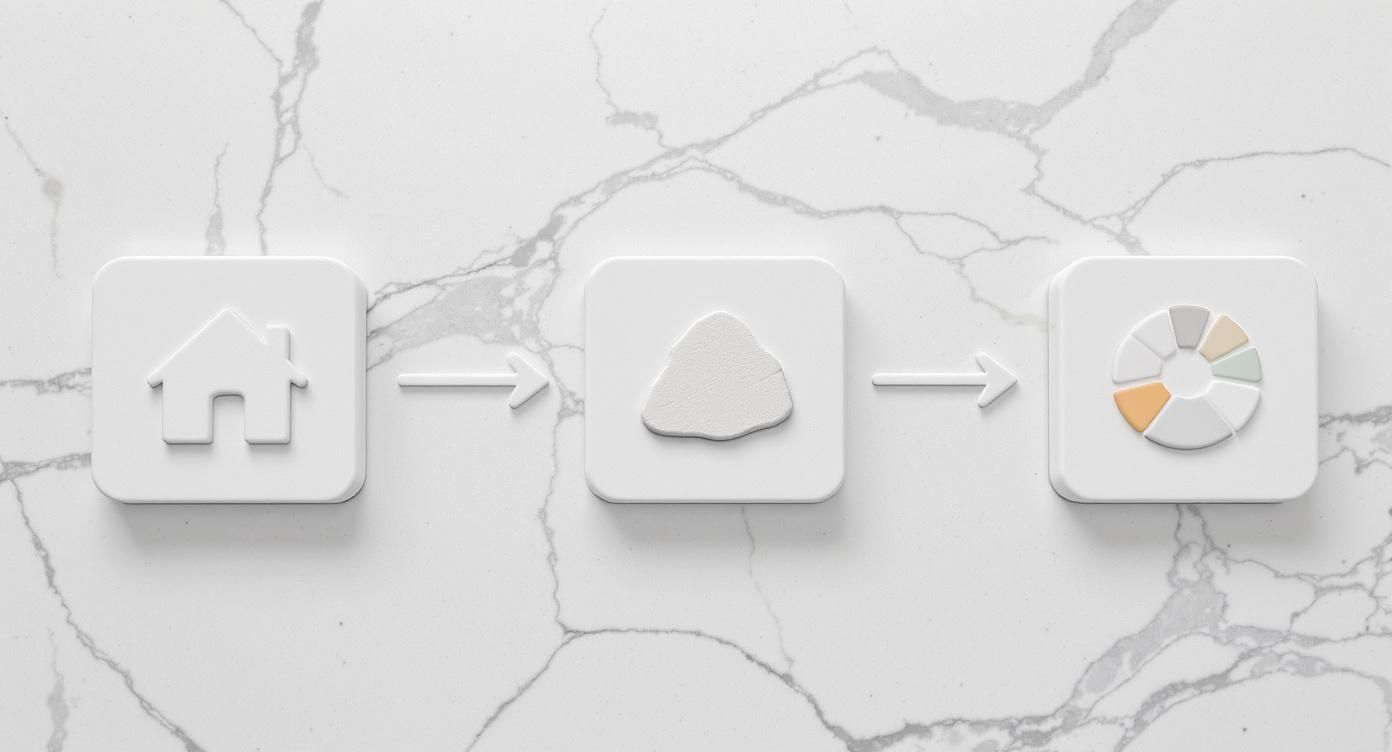
This visual guide shows how aligning the stone’s character with your property’s overall design creates a more unified and intentional curb appeal.
Maintain consistent joint spacing as you place each stone. Use small stone chips or shims as temporary supports to hold stones in place while the mortar sets.
Proper installation is non-negotiable for longevity. A meticulous application ensures that the real natural stone veneer performs as intended, providing decades of maintenance-free service and resisting the harsh freeze–thaw cycles common in New England.
Professional Finishing Capping and Mounting
With the thin stone veneer installed, the final details of capping the post and mounting the mailbox complete the project. These steps provide a professional finish and protect the structure from the elements.
Selecting and Installing a Durable Cap
A proper cap is essential for any exterior stone post, particularly in regions with freeze-thaw cycles. It prevents water from penetrating the core structure, where it could freeze, expand, and cause damage.
Solid granite slabs are a classic and effective option, providing a timeless look and an impermeable surface. Another approach is to use leftover pieces of Stoneyard thin veneer to fabricate a custom cap that matches the post.
The cap must overhang the post by at least one inch on all sides. This overhang directs rainwater away from the stone face, preventing staining and moisture issues. Set the cap in a bed of mortar and tool the joint to create a clean, watertight seal. For more detailed techniques, refer to our guide on how to cap stone veneer columns.
Mounting the Mailbox to USPS Standards
The mailbox must be mounted securely and in compliance with U.S. Postal Service (USPS) guidelines to ensure safe and efficient mail delivery.
USPS requirements dictate that:
- The mailbox opening must be positioned 41 to 45 inches from the ground or road surface.
- The front of the mailbox should be set back 6 to 8 inches from the curb or the edge of the road.
Verify measurements before drilling into the stone cap. Use stainless steel hardware to resist rust and corrosion. Drill pilot holes into the stone cap with a masonry bit, then securely fasten the mailbox mounting bracket.
A properly capped and mounted mailbox post is more than just functional—it’s a testament to high-level craftsmanship. Taking the time to get these final steps right protects the structural integrity of the real stone veneer and ensures your project remains a durable, low-maintenance feature for years.
Real Stone vs. Manufactured Stone for Mailbox Posts
When planning a stone mailbox post, the primary material choice is between authentic natural stone and manufactured substitutes. While brands like Eldorado Stone (https://eldoradostone.com), Coronado Stone (https://coronado.com), and Cultured Stone (https://www.culturedstone.com) produce products that mimic the look of real stone, they are fundamentally different materials. These differences become apparent in harsh weather climates.
Manufactured products are cement-based veneers cast in molds and tinted with pigments. The color is only surface-deep. Over time, UV exposure can cause fading, and the surface is prone to chipping, revealing the gray concrete core. As a porous material, it absorbs water, leading to deterioration during freeze-thaw cycles.
The Durability of Real New England Stone
Stoneyard’s New England thin stone veneer is 100% real natural stone, sourced from the region and crafted at our facility in Littleton, MA. With natural stone, the color and texture are integral, running through the entire body of each piece. This means it will never fade or peel.
Our authentic stone is naturally dense with low water absorption, making it resistant to damage from repeated freezing and thawing. This is why every Stoneyard product is designated Harsh Climate Approved (HCA)—it is built to withstand decades of New England weather with minimal maintenance.
Natural New England stone veneer delivers performance that lasts for decades, with zero color fading. Because the color is consistent all the way through, any future chips from an accidental impact will only reveal more of the same authentic stone—a stark contrast to pigmented concrete products that expose their artificial core when damaged.
Long-Term Value and Market Trends
The residential mailboxes market, valued at USD 95.2 million in 2023, is projected to surge to USD 296.2 million by 2031, according to Verified Market Research. This trend indicates a growing demand for durable, high-quality curb appeal solutions like real stone.
While the upfront material cost for real stone veneer may be higher than manufactured products, the long-term value is superior. Installation labor is similar for both, but authentic stone’s longevity and low maintenance requirements prevent costly future repairs or replacements. The authenticity of real stone also adds measurable resale value to a property. For a complete comparison, review our guide on the differences between faux stone vs. natural stone.
Answering Your Stone Mailbox Post Questions
Proper planning is key to constructing a stone mailbox post that will perform for decades in New England weather. Here are answers to common technical questions.
How Deep Does the Footing Need to Be?
The footing depth is critical for preventing damage from frost heave. To avoid this, the footing must be placed below the local frost line.
In most of New England, this means a depth of 36 to 48 inches. However, requirements can vary by municipality. Always confirm the exact depth with your local building code enforcement office before excavation.
What’s the Right Substrate for Thin Stone Veneer?
Natural thin stone veneer requires a solid, cement-based substrate for a permanent bond. Applying it directly over a wooden post will lead to failure.
Acceptable core structures include:
- Poured concrete columns, reinforced with rebar.
- Concrete masonry unit (CMU) cores. For maximum durability, fill the hollow cells with concrete.
A wood core lacks the necessary stability, and mortar will not adhere to it properly.
What Tools Do I Need to Cut the Stone?
While many full-sized pieces can be set without modification, trimming some stones is necessary for a tight, professional fit, especially around openings or at the top course.
The standard tool for this task is a 4-inch grinder fitted with a diamond blade, which provides clean, precise cuts through dense natural stone. For irregular shapes like our Mosaic pattern, a traditional mason’s hammer can be used for minor shaping to create a more rustic, hand-chipped edge.
Always wear safety glasses and a dust mask when cutting stone.
Explore the full Stoneyard Thin Stone Veneer Collection — real New England stone, made in the USA.
Order free samples at https://stoneyard.com/stone-samples/ or schedule a virtual showroom visit at https://stoneyard.com/contact/.

